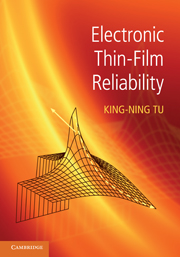Book contents
- Frontmatter
- Dedication
- Contents
- Preface
- 1 Thin-film applications to microelectronic technology
- 2 Thin-film deposition
- 3 Surface energies
- 4 Atomic diffusion in solids
- 5 Applications of the diffusion equation
- 6 Elastic stress and strain in thin films
- 7 Surface kinetic processes on thin films
- 8 Interdiffusion and reaction in thin films
- 9 Grain-boundary diffusion
- 10 Irreversible processes in interconnect and packaging technology
- 11 Electromigration in metals
- 12 Electromigration-induced failure in Al and Cu interconnects
- 13 Thermomigration
- 14 Stress migration in thin films
- 15 Reliability science and analysis
- Appendix A A brief review of thermodynamic functions
- Appendix B Defect concentration in solids
- Appendix C Derivation of Huntington's electron wind force
- Appendix D Elastic constants tables and conversions
- Appendix E Terrace size distribution in Si MBE
- Appendix F Interdiffusion coefficient
- Appendix G Tables of physical properties
- Index
- References
13 - Thermomigration
Published online by Cambridge University Press: 05 July 2014
- Frontmatter
- Dedication
- Contents
- Preface
- 1 Thin-film applications to microelectronic technology
- 2 Thin-film deposition
- 3 Surface energies
- 4 Atomic diffusion in solids
- 5 Applications of the diffusion equation
- 6 Elastic stress and strain in thin films
- 7 Surface kinetic processes on thin films
- 8 Interdiffusion and reaction in thin films
- 9 Grain-boundary diffusion
- 10 Irreversible processes in interconnect and packaging technology
- 11 Electromigration in metals
- 12 Electromigration-induced failure in Al and Cu interconnects
- 13 Thermomigration
- 14 Stress migration in thin films
- 15 Reliability science and analysis
- Appendix A A brief review of thermodynamic functions
- Appendix B Defect concentration in solids
- Appendix C Derivation of Huntington's electron wind force
- Appendix D Elastic constants tables and conversions
- Appendix E Terrace size distribution in Si MBE
- Appendix F Interdiffusion coefficient
- Appendix G Tables of physical properties
- Index
- References
Summary
Introduction
When an inhomogeneous binary solid solution or alloy is annealed at constant temperature and constant pressure, it will become homogeneous to lower the free energy. Conversely, when a homogeneous binary alloy is annealed at constant pressure but under a temperature gradient, i.e. one end of it is hotter than the other, the opposite will happen: the alloy will become inhomogeneous, and the free energy increases. This de-alloying phenomenon is called the Soret effect, as mentioned in Chapter 10. It is due to thermomigration or mass migration driven by a temperature gradient [1–3]. Since the inhomogeneous alloy has higher free energy than the homogeneous alloy, thermomigration is an energetic process which transforms a phase from a low-energy to a high-energy state. It is unlike a conventional phase transformation which occurs by lowering Gibbs free energy.
In thermodynamics, under homogeneous external conditions defined by a constant temperature and constant pressure (for example, if T is fixed at 100 °C and p is fixed at atmospheric pressure), a thermodynamic system will minimize its Gibbs free energy, and it will move toward the equilibrium condition at the given T and p. Both enthalpy and entropy are state functions, so the Gibbs free energy of the equilibrium state is defined when T and p are given. On the other hand, if the external conditions are inhomogeneous, for example, having different temperatures at the two ends of a sample in thermomigration, the equilibrium state of minimum Gibbs free energy is unattainable.
- Type
- Chapter
- Information
- Electronic Thin-Film Reliability , pp. 289 - 308Publisher: Cambridge University PressPrint publication year: 2010



